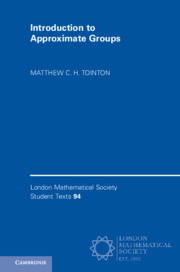Book contents
- Frontmatter
- Dedication
- Contents
- Preface
- 1 Introduction
- 2 Basic Concepts
- 3 Coset Progressions and Bohr Sets
- 4 Small Doubling in Abelian Groups
- 5 Nilpotent Groups, Commutators and Nilprogressions
- 6 Nilpotent Approximate Groups
- 7 Arbitrary Approximate Groups
- 8 Residually Nilpotent Approximate Groups
- 9 Soluble Approximate Subgroups of GLn(C)
- 10 Arbitrary Approximate Subgroups of GLn(C)
- 11 Applications to Growth in Groups
- References
- Index
2 - Basic Concepts
Published online by Cambridge University Press: 31 October 2019
- Frontmatter
- Dedication
- Contents
- Preface
- 1 Introduction
- 2 Basic Concepts
- 3 Coset Progressions and Bohr Sets
- 4 Small Doubling in Abelian Groups
- 5 Nilpotent Groups, Commutators and Nilprogressions
- 6 Nilpotent Approximate Groups
- 7 Arbitrary Approximate Groups
- 8 Residually Nilpotent Approximate Groups
- 9 Soluble Approximate Subgroups of GLn(C)
- 10 Arbitrary Approximate Subgroups of GLn(C)
- 11 Applications to Growth in Groups
- References
- Index
Summary
We motivate the definitions of sets of small doubling and approximate groups, and introduce their basic properties. We show that random sets of integers (suitably defined) have large expected doubling. We prove Freiman’s theorem that a subset of a group of doubling less than 2/3 is close to a finite subgroup. We prove the Plünnecke–Ruzsa inequalities, Ruzsa’s triangle inequality and Ruzsa’s covering lemma. We motivate in detail the definition of an approximate group, and reduce the study of sets of small doubling to the study of finite approximate groups. We show that the notions of small tripling and approximate group are stable under intersections and group homomorphisms. We introduce Freiman homomorphisms and present their basic properties.
Keywords
Information
- Type
- Chapter
- Information
- Introduction to Approximate Groups , pp. 11 - 34Publisher: Cambridge University PressPrint publication year: 2019
